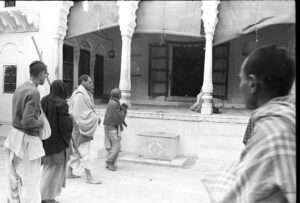
May my head always very respectfully bow down to salute Vrindavana. May my tongue be enthusiastic to glorify its transcendental qualities. May my hands clean its newly blossoming groves. May my feet wander in Vrindavana. May my ears hear its glories. May my eyes gaze upon Vrindavana. May my mind always meditate upon Vrindavana[1].”
On this earth, Sri Vrindavana dhama is a replica of that supreme Goloka Vrindavana located in the spiritual sky. When Lord Krishna descends to this material world, His transcendental abode also descends, along with His entourage and most confidential friends.
For the benefit of us all, the Lord sported on that particular tract of land, performing transcendental pastimes with His eternal associates:
This tract of land is considered to be the topmost place of pilgrimage in India. This land is sacred because Lord Krishna traveled through it many times. From the very beginning of His appearance, He was at Mathura in the house of His maternal uncle Kamsa and He was reared by His foster father Maharaja Nanda at Vrindavana. There are still many devotees of the Lord lingering there in ecstasy in search of Krishna and His childhood associates, the gopis. It is not that such devotees meet Krishna face to face in that tract of land, but for the devotees eagerly searching after Krishna, it is as good as seeing Him personally. How this is so cannot be explained, but it is factually realized by those who are pure devotees of the Lord. Philosophically, one can understand that Lord Krishna and His remembrance are on the absolute plane and that the very idea of searching for Him at Vrindavana in pure God consciousness gives more pleasure to the devotee than seeing Him face to face[2].
Sri Vrindavana dhama is situated ninety miles southeast of Delhi and comprises about eighty-four square miles in the district of Mathura, India.
There are over 5000 temples in Vrindavana.
Of all the temples in Vrindavana, ninety percent belong to the Gaudiya-Vaishnava sect, the followers of the teachings of Lord Caitanya Mahaprabhu and Nityananda, and seven are very famous[3].
Between the seven most important temples of Vrindavana, the Radha Damodara temple holds a very special position, for many reasons.
In 1516 Sri Rupa and Sri Sanatana Goswamis arrived in the sacred land of Vraja.
Lord Chaitanya had ordered the two brothers to uncover the places of Sri Krishna’s pastimes in the holy Vrindavana that had disappeared over the centuries.
Srila Prabhupada once said:
“Vrindavana is the gift of Rupa and Sanatana Goswamis”.
Although wandering through Vrindavana’s many forests, living austerely and residing each night under a different tree, the Goswamis remained for short periods at selected places of Krishna’s lilas.
Sri Rupa Gosvami performed bhajan in Ter Kadamba (near Nandagram), Varsana, Radha Kunda and Seva Kunja.
Their bhajan kutirs were temporary arrangements like the hollow of a tree, under a thorny bush, or in an underground cave. In these austere, natural settings, Rupa Gosvami and Sanatana Gosvami chanted Hari Nama and wrote the most exalted and sublime transcendental literature about the loving affairs of Sri Radha and Krishna.
[1] From Sri Vrindavana mahimamrita
[2] Srimad-Bhagavatam 3.1.24 purport.
[3] Caitanya Caritamrita Adi 5.232 purport
This is a section of the book “Brilliant as the Sun”.
To buy the complete book, click above
Post view 481 times



Leave a Reply